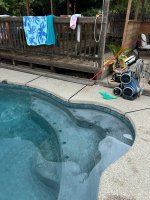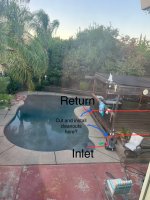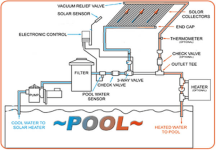This is my first post but I have been lurking for a few months now. My TF-Pro kit comes next week and I will be doing my first proper SLAM. I had done the Clorox recommended treatment to this point but after learning more I think they are a bit misleading.
We recently bought our first house with a pool. I have been having a hard time keeping the free chlorine up and I’m wondering if it’s related to the old heater plumbing for the pool being full of algae. It’s about 500’ of 1.5” abs that runs with its own pump on a timer.
I bought a pump with the intention of fixing it but found that I can’t get the pump to pull a vacuum(the pipe to it is run under the deck and has about a 6” hump in the middle over 15’). Even if I got it to pump water the current system is leaks like crazy and would need to be replaced.
All that being said I think for the time being I need to abandon the heater until we decide what we are going to do with the covered deck.

This is the return for the old heater. It runs about where the red line is under the deck.

This is the intake for the heater.
The question I have is for the time being can I cut the 90s off these pipes and install clean outs that I occasionally flush out? Also does anyone successfully run a pool heating system that runs on its own pump like this or do I eventually need to do some plumbing to install a valve as I have seen is the norm?
We recently bought our first house with a pool. I have been having a hard time keeping the free chlorine up and I’m wondering if it’s related to the old heater plumbing for the pool being full of algae. It’s about 500’ of 1.5” abs that runs with its own pump on a timer.
I bought a pump with the intention of fixing it but found that I can’t get the pump to pull a vacuum(the pipe to it is run under the deck and has about a 6” hump in the middle over 15’). Even if I got it to pump water the current system is leaks like crazy and would need to be replaced.
All that being said I think for the time being I need to abandon the heater until we decide what we are going to do with the covered deck.

This is the return for the old heater. It runs about where the red line is under the deck.

This is the intake for the heater.
The question I have is for the time being can I cut the 90s off these pipes and install clean outs that I occasionally flush out? Also does anyone successfully run a pool heating system that runs on its own pump like this or do I eventually need to do some plumbing to install a valve as I have seen is the norm?









